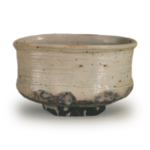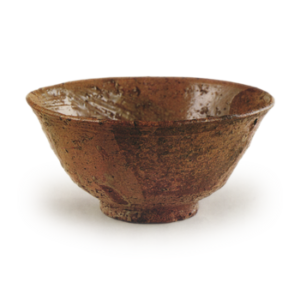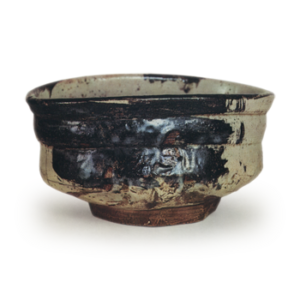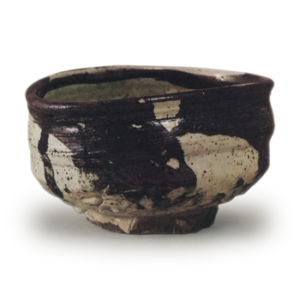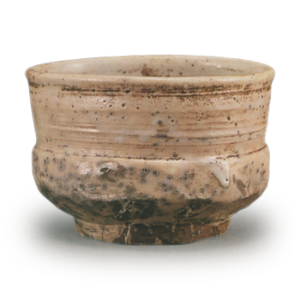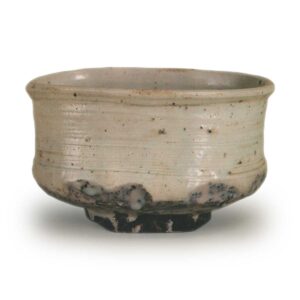
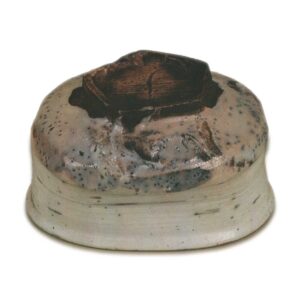
Height: 7.3-7.5cm
Diameter: 9.8-13.0cm
Outer diameter of foot ring: 6.4-6.5cm
Height of foot ring: 0.7cm
In the Taisho Meiki Kan, the following four bowls are listed as excellent examples of Gosomaru: the Gosomaru by Furuta Kora, the Gosomaru by the Fujita family, the Gosomaru by Kato Masayoshi, and this Gosomaru , and six bowls of black brushware, including the Yuhi of the Inoue family, the Kurofuke of the Mitsui family, the Hihakama of the Fujita family, the Katata owned by Masuda Dono, the Kurofuke of the Iwasaki family, and the Kurofuke of the Osaka Wada family.
This Hakugoshomaru is inferior to the Hakugoshomaru by Furuta Koryo and Kato Masayoshi in terms of appearance, especially the shape of the foot ring, but it has a leak in the lower part of the body, and in terms of its rich atmosphere, it is hard to find anything that can match it. Unfortunately, however, this atmosphere is not well captured in the Taisho Meiki Kan. The upper body is made of a pure white porcelain-like material, but unlike modern porcelain, the particles are coarse because it was patted with a water wheel, and the firing temperature was low, so it has a certain old-fashioned and familiar feel. The foot ring is not glazed, but a transparent white glaze is applied to the entire inside and outside, and this melts gently. However, in accordance with the rules of Gosomaru, the bottom half of the bowl is scraped with a spatula, and this bowl also has nine scraped lines on the bottom. The rough particles of the clay stand out due to the scraping, and when the glaze is applied over this, bubbles form on the glaze surface after firing. Also, because the firing was not done properly and the clay was not fired hard enough, tea stains seeped into the bubbles and permeated the clay, causing it to leak. As the Gakushu-shu commentary on this tea bowl says, “It is a small bowl with purple stains and is magnificent”, the beauty of the purple stains is the highlight of this tea bowl above all else.
The shape was made on the potter’s wheel, and the thick rim was also formed on the wheel, but the rim was pressed from both sides when it was still wet to make it oval, and the waist was roughly scraped. The foot is five-sided and stands on the potter’s wheel, and the inside of the foot has also been scraped with a scraper. There is a kiln mark carved on the underside of the base, but this is not a kiln mark, and is probably a direct copy of the kind of inscription often seen on Oribe ware. We have not seen the same type of kiln mark on the Shiro Gosho Maru, but we have seen it on the Kuro Hakeme of the Mitsui family, the Kuro Hakeme of the Fujita family, the Kuro Hakeme of the Iwasaki family, and the Kuro Hakeme in the collection of Mr. Kuzoemon Wada, and each of these has a different inscription. It is thought that some of the Oribe Kutsu tea bowls were sent to Korea, and that the Gosomaru was made using these as a model. In any case, the Gosomaru is a copy of the Oribe Kutsu, and is the most artificial of the Korean tea bowls. However, there is a certain Korean-like naivety to the way it was made, and the interesting texture of the clay and the way it is fired are also enjoyable. This tea bowl in particular has a leak at the bottom, and is a tea bowl with a truly rich sense of sentiment. The inside of the bowl has a spiral-shaped tea pool, and there is a crescent-shaped fire pit in the middle, but there are no cracks or fissures.
The accessory bag is red brocade with a feathered pattern. The inner box is paulownia wood, and the inscription on the lid is by Katagiri Sekishu, and it says “Koryo tea bowl”. The outer box is black lacquer, and the inscription on the lid in silver powder characters “Furuta Koryo” is by Nagata Shinsetsu.
The “Gogaku-shu” (a collection of writings by the scholar Fujita Hikosaburo) states that “the tea bowl came from Awa, then to Kaga, then to Osaka, where it was owned by Fujita Hikosaburo, and after the war it left the Fujita family and is now in Aichi Prefecture.

